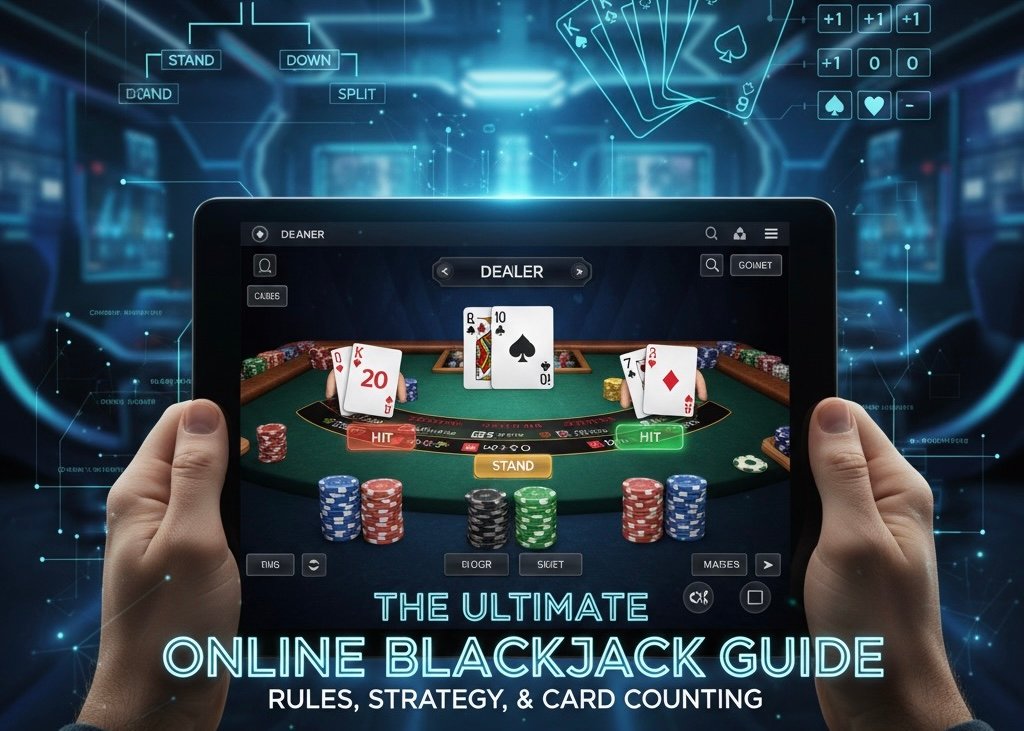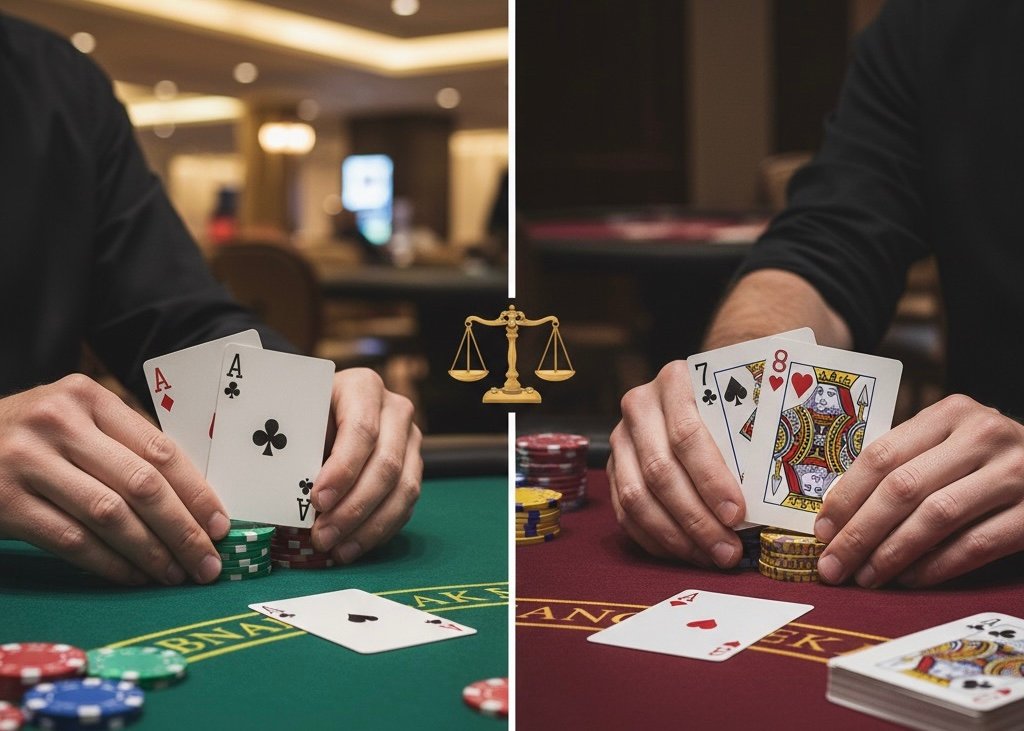Blackjack, often hailed as the king of casino card games, owes its enduring popularity to a perfect blend of luck and skill. Unlike purely random games, your decisions at the Blackjack table directly influence your chances of winning. And no decisions are more fundamental, or more critical, than knowing when to hit or stand in Blackjack.
These two actions form the bedrock of Basic Strategy – a mathematically proven method that minimises the house edge and gives you the best possible chance against the dealer. Ignore them, and you’re essentially throwing money away. Master them, and you transform from a casual punter into a formidable player.
This guide will demystify the art of hitting and standing, providing clear, actionable advice based on every possible hand scenario. Get ready to ditch the guesswork and play Blackjack with confidence.
Highlights:
- Basic Strategy is the mathematically optimal way to play Blackjack, telling you when to hit, stand, double down, or split.
- The decision to hit or stand is always based on your hand total and the dealer’s upcard.
- Standing on a hard 17 or more is a golden rule, as hitting is too risky.
- Always hit on a hard 11 or less, as there’s no risk of busting.
- Knowing when to hit or stand is crucial for reducing the house edge and improving your long-term odds.
The Core Concept: Your Hand vs. The Dealer’s Upcard
Every decision you make in Blackjack hinges on two pieces of information:
- Your Hand Total: The sum of the cards you’ve been dealt.
- The Dealer’s Upcard: The one card the dealer shows face-up to all players.
You can’t see the dealer’s face-down card, but their upcard provides a crucial clue about their likely hand total. For instance, a dealer showing a 6 is much more likely to bust than a dealer showing a 7 or an Ace. Basic Strategy leverages this probability to guide your choices.
Understanding “Hard” vs. “Soft” Hands
Before we dive into specific rules, it’s vital to understand the difference between a “hard” and a “soft” hand. This distinction significantly impacts whether you hit or stand.
- Hard Hand: Any hand that either contains no Ace, or contains an Ace that must count as 1 to avoid busting.
- Examples: 10 + 7 = Hard 17; 9 + 5 = Hard 14; Ace + 8 + 6 = Hard 15 (if the Ace was 11, you’d be bust).
- Soft Hand: Any hand that contains an Ace that can count as either 1 or 11 without busting.
- Examples: Ace + 6 = Soft 17 (could be 7 or 17); Ace + 2 = Soft 13 (could be 3 or 13).
The flexibility of a soft hand makes it much safer to hit, as you can’t bust on the next card.
When to ALWAYS Hit
There are certain scenarios where hitting is almost always the correct move, regardless of the dealer’s upcard (unless you’re considering doubling down, which we’ll cover later).
- Any Hard Hand 11 or Less: If your total is 11 or below, you cannot bust on the next card, no matter what it is. A 10 will give you 21, and any other card will leave you with a safe total.
- Example: You have 8 + 3 = Hard 11. You should always hit.
- Most Soft Hands 17 or Less: While a soft 17 might sound good, remember that the Ace can count as 1. Hitting a soft hand of 17 or less can only improve your total or keep it safe.
- Example: You have Ace + 6 = Soft 17. Often, you should hit, as you can’t bust and might improve to a higher total like 18 or 19.
- When to ALWAYS Stand
Conversely, knowing when to hold your nerve and stand is equally important.
- Any Hard Hand 17 or More: This is a golden rule. Your chances of busting by hitting a 17 or higher are extremely high, outweighing any potential benefit.
- Example: You have 10 + 7 = Hard 17. Always stand.
- Hard 12 to 16 Against a Dealer Bust Card: This is where the dealer’s upcard becomes critical. If the dealer shows a 2, 3, 4, 5, or 6, they have a high probability of busting when they have to hit. In these situations, you should stand on any hard hand from 12 to 16. You’re betting the dealer will bust before you do.
- Example: You have 10 + 4 = Hard 14. Dealer has a 5. Stand.
- Soft 19 or 20: These are strong totals. Hitting them risks reducing your total or busting, with very little upside.
- Example: You have Ace + 8 = Soft 19. Stand.
The Tricky Middle Ground: Specific Scenarios
This is where Basic Strategy charts become invaluable. Here are some of the most common tricky situations:
- Hard 12:
- Stand against a dealer’s 4, 5, or 6 (dealer likely to bust).
- Hit against a dealer’s 2, 3, 7, 8, 9, 10, or Ace.
- Hard 13, 14, 15, 16:
- Stand against a dealer’s 2, 3, 4, 5, or 6 (dealer likely to bust).
- Hit against a dealer’s 7, 8, 9, 10, or Ace.
- Soft 18 (Ace + 7): This is often a good hand, but depends on the dealer.
- Stand against a dealer’s 2, 7, or 8.
- Hit against a dealer’s 9, 10, or Ace (trying to improve without busting).
- Double Down against a dealer’s 3, 4, 5, or 6 (if allowed, and a strong opportunity).
These are general guidelines. For a precise strategy, always refer to a detailed Basic Strategy chart for the specific ruleset of the Blackjack game you’re playing (e.g., number of decks, dealer hits/stands on soft 17).
Beyond Hit/Stand: Other Key Decisions
While hit and stand are central, Blackjack involves other crucial decisions that also contribute to optimal play:
- Double Down: Doubling your initial bet and taking exactly one more card. This is typically done when you have a strong hand (e.g., hard 10 or 11) and the dealer has a weak upcard (e.g., 2-9).
- Split: If you’re dealt two cards of the same rank (e.g., two 8s), you can split them into two separate hands, playing each independently. Always split Aces and 8s, never split 4s, 5s, or 10s.
- Surrender: Giving up half your bet and your hand if you believe your chances of winning are extremely low (e.g., hard 16 against a dealer’s 10). Not all casinos offer this.
- Insurance: A side bet offered when the dealer shows an Ace, paying 2:1 if the dealer has Blackjack. Always avoid insurance; it’s a sucker bet with a high house edge.
Mastering these, in conjunction with hit and stand, allows for truly optimal play. For more comprehensive insights into the world of online casinos, including strategy guides for various games, remember to visit our blog.
While understanding this specific rule is vital, it is just one piece of the puzzle. To see how this fits into the broader winning approach, we recommend studying our full breakdown in The Ultimate Online Blackjack Guide: Rules, Strategy & Card Counting.
The Bottom Line
Knowing when to hit and when to stand is not a matter of guesswork or gut feeling; it’s a skill based on mathematical probabilities. By consistently applying Basic Strategy, you empower yourself to make the best possible decisions in every Blackjack hand, significantly reducing the house advantage and increasing your long-term success.
Take the time to learn these rules, practice them, and you’ll transform your Blackjack game. Remember, the goal is not just to win, but to play smart.
You can explore all our casino insights on The Casino Count homepage.
Disclaimer: The content on this page is provided for informational and entertainment purposes only. Gambling involves financial risk, and you should only ever play with money you can afford to lose. Please gamble responsibly.




Leave a Reply to The Ultimate Online Blackjack Guide: Rules, Strategy & Card Counting – The Casino Count Cancel reply